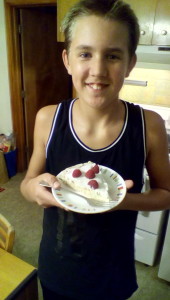One of our primary focuses in our homeschool this school year is world geography. For the most part, our main social studies focus is always on history, and this year Zander is combining the two with a study of the Eastern Hemisphere- a part of the world rarely studied in-depth in American schools. He’s studying the history and the geography of Australia, Africa, Asia, Antarctica, and all the little island nations floating in that general area. It’s a fascinating study- one that Abigail enjoyed for her sixth grade year, so I thought it was worth repeating with the little man for his own journey through sixth grade.
As he studies each region or country, the opportunity comes up to do a project related to that area of the world. Things like research reports, craft projects, topography mapping are some of the recommendations in the guide we are using. Of course, there are frequently food suggestions, but I confess, I didn’t really see Zander choosing many of the food options this year. He’s not been as interested in cooking as his sister, and though he will definitely learn how to cook before he leaves the nest, it won’t be by his choice.
Or will it?
Because when he saw the options given for the country of New Zealand, he very quickly told me he wanted to make a pavlova. Then he asked me what a pavlova was. As soon as he saw the pictures, he wanted to go ahead with the project, and since I had everything necessary on hand, we sought out to learn to make a pavlova together.
I’ve only ever had pavlova once, and that was many years ago when we were hosting a weekly group in our home. A friend made a pavlova, and while I absolutely loved it, for some reason it never came to me to make one myself. Be assured, it’s going into the file as something to consider for company in the future, because Zander and I discovered that it is actually very easy to make.
The difficult part is carefully separating the 4 eggs needed for the recipe. Zander has seen many a cooking show where separating eggs proves to be a challenge, so he was a little nervous about that step, but managed with flying colors. After that, it was really easy to beat the egg whites to stiff peaks and then add the remaining ingredients. We made one large pavlova, which Zander spread out into a 9-inch circle, and then baked for one hour at 300ºF. Once it cooled, we smeared on some lightly sweetened whipped cream, and his choice of fruit was raspberries. The tangy raspberries were absolutely perfect with the sweet meringue base. The only thing I would have liked better would have been many more raspberries- Zander was a little sparing in his decoration. But overall, the pavlova was impressive and delicious.
We’re moving into Japan this week for school, and I really hope he chooses another cooking challenge. Eating our way through Asia sounds absolutely wonderful to me!
One quick note about this recipe. I’ve seen many instances over the years of people trying to cut back on the amount of sugar in baked goods. By all means, if that is your M.O. keep doing it, just don’t do it for this recipe. The proportion of sugar to egg whites and cornstarch is critical to the success of the meringue holding it’s shape and texture. If you want to reduce the sugar, do so with the toppings. I sweetened our cream with a few tablespoons of powdered sugar, but you can certainly skip that part.
Oh, and surprise of surprise, this held perfectly overnight in a refrigerator. I expected that when we went to get it out the second day it would have softened and turned into a pile of goo, and that was not the case. It was just as good the second day as it was the first.
Pavlova
4 egg whites 1 1/4 cups white sugar 1 teaspoon vanilla extract 1 teaspoon lemon juice 2 teaspoons cornstarch 1 pint of heavy cream fruit of your choice for topping Directions:Preheat oven to 300ºF. Line a baking sheet with parchment paper. Draw a 9-inch circle on the parchment paper with a pencil.
In a large bowl, beat the egg whites until stiff but not dry. Gradually add in the sugar, about 1 tablespoon at a time, beating well after each addition. Beat until thick and glossy. Gently fold in the vanilla, lemon juice and cornstarch.
Spoon mixture inside the circle drawn on the parchment paper. Working from the center, spread mixture toward the outside edge, building edge slightly. This should leave a slight depression in the center.
Bake for 1 hour. Cool on a wire rack.
In a small bowl, beat the heavy cream until stiff peaks form; set aside. Remove the paper and place the meringue on a flat serving plate. Fill the center of the meringue with whipped cream and top with the fresh fruit of your choice.
